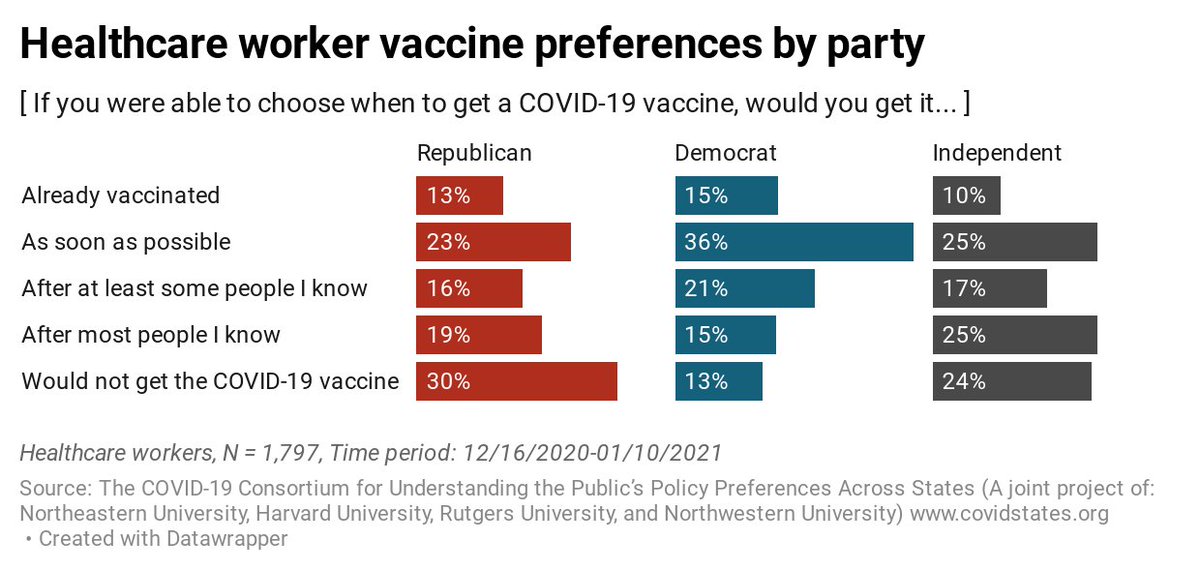
See our latest COVID states report, this time looking at vaccination issues wrt health care workers.
Bottom line:
There are major issues re who is getting vaccinated, in terms of gender, race, status.
& looming problems wrt vaccine resistance
covidstates.org 1/14
Bottom line:
There are major issues re who is getting vaccinated, in terms of gender, race, status.
& looming problems wrt vaccine resistance
covidstates.org 1/14
First, simple thing to note: the attitudes of health care workers re vaccination are pretty close to the general population, except for the fact that they have had access to vaccines earlier than other folks.
So, they provide an indicator for how things might go more generally.
So, they provide an indicator for how things might go more generally.

So, how has it gone?
Not great, in terms of equity.
(1) Gender: Men are twice as likely to report getting vaccinated than women, & half as likely to be vaccine resistant. 3/14
Not great, in terms of equity.
(1) Gender: Men are twice as likely to report getting vaccinated than women, & half as likely to be vaccine resistant. 3/14

(2) Education: those w/ a grad degree about 3x as likely to be vaccinated as those w/ HS or less, & about a third as likely to be vaccine resistant. 4/14 

(3) Income: Those earning over 150k are about 3x as likely to be vaccinated as those earning under 50k, & also about third as likely to be vaccine resistant. 5/14 

(4) Race: there are some substantial racial differences, though not as huge as gender/education/income. Marginally lower vaccination rates for African Ams & Hispanics than Whites and Asian Ams, but substantial diffs in vaccine resistance. 6/14 

(5) Partisanship: Marginal differences in vaccination rates among Ds, Rs, and Is; but Rs and Is have much higher levels of vaccine resistances than Ds. 7/14 

These factors, I'll note, are partially additive. So, in an multivariable analysis a hypothetical white, male doc age 50, earning 200k had a 45% chance of being vaccinated; and a black, female, nursing assistant same age a 6% chance. 8/14
& the predicted probability of vaccine resistance for that doc is 1%; for that nursing assistant 31%. 9/14
So: mission control, we've got a vaccination problem.
"We" means (1) health care institutions; and (2) society. More in the report, but this really means that there has to be proactive outreach re vaccinations. 10/14
"We" means (1) health care institutions; and (2) society. More in the report, but this really means that there has to be proactive outreach re vaccinations. 10/14
Health care institutions are esp well situated because it is clear (see our earlier report) that health care professionals and scientists are best situated to discuss vaccines. It's just not clear that these institutions have encouraged those conversations internally. 11/14
& those are the conversations we need to be having more generally in society. 12/14
Report w/
@matthewabaum
@davidlazer
@Ognyanova
@MauSantillana
@mattysimonson
@_Jon_Green
@jennifer_lin16
@AdinaGitomer
@royperlis
@Atauslu
and Alexi Quintana and Jamie Druckman
13/14
@matthewabaum
@davidlazer
@Ognyanova
@MauSantillana
@mattysimonson
@_Jon_Green
@jennifer_lin16
@AdinaGitomer
@royperlis
@Atauslu
and Alexi Quintana and Jamie Druckman
13/14
• • •
Missing some Tweet in this thread? You can try to
force a refresh




